Related Research Articles
Pulp magazines were inexpensive fiction magazines that were published from 1896 to the late 1950s. The term "pulp" derives from the cheap wood pulp paper on which the magazines were printed. In contrast, magazines printed on higher-quality paper were called "glossies" or "slicks". The typical pulp magazine had 128 pages; it was 7 inches (18 cm) wide by 10 inches (25 cm) high, and 0.5 inches (1.3 cm) thick, with ragged, untrimmed edges.

Robert Anson Heinlein was an American science fiction author, aeronautical engineer, and naval officer. Sometimes called the "dean of science fiction writers", he was among the first to emphasize scientific accuracy in his fiction, and was thus a pioneer of the subgenre of hard science fiction. His published works, both fiction and non-fiction, express admiration for competence and emphasize the value of critical thinking. His plots often posed provocative situations which challenged conventional social mores. His work continues to have an influence on the science-fiction genre, and on modern culture more generally.

Starship Troopers is a military science fiction novel by American writer Robert A. Heinlein. Written in a few weeks in reaction to the US suspending nuclear tests, the story was first published as a two-part serial in The Magazine of Fantasy & Science Fiction as Starship Soldier, and published as a book by G. P. Putnam's Sons in December 1959.
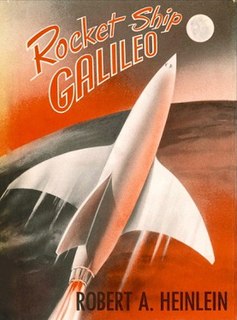
Rocket Ship Galileo, a juvenile science-fiction novel by the American writer Robert A. Heinlein, published in 1947, features three teenagers who participate in a pioneering flight to the Moon. It was the first in the Heinlein juveniles, a long and successful series of science-fiction novels published by Scribner's. Heinlein originally envisioned the novel as the first of a series of books called "Young Rocket Engineers". Publishers initially rejected the script, judging going to the moon as "too far out".
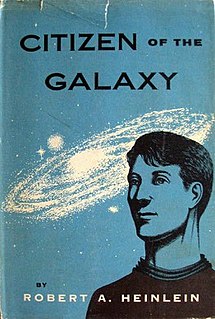
Citizen of the Galaxy is a science fiction novel by American writer Robert A. Heinlein, originally serialized in Astounding Science Fiction and published in hardcover in 1957 as one of the Heinlein juveniles by Scribner's. The story is heavily influenced by Rudyard Kipling's Kim.

Stranger in a Strange Land is a 1961 science fiction novel by American author Robert A. Heinlein. It tells the story of Valentine Michael Smith, a human who comes to Earth in early adulthood after being born on the planet Mars and raised by Martians, and explores his interaction with and eventual transformation of Terran culture.
" '—All You Zombies—' " is a science fiction short story by American writer Robert A. Heinlein. It was written in one day, July 11, 1958, and first published in the March 1959 issue of Fantasy and Science Fiction magazine after being rejected by Playboy.
"Life-Line" is a short story by American author Robert A. Heinlein. Published in the August 1939 edition of Astounding, it was Heinlein's first published short story.

"'—And He Built a Crooked House—'" is a science fiction short story by American writer Robert A. Heinlein, first published in Astounding Science Fiction in February 1941. It was reprinted in the anthology Fantasia Mathematica in 1958, and in the Heinlein collections The Unpleasant Profession of Jonathan Hoag in 1959 and The Best of Robert Heinlein in 1973. The story is about a mathematically inclined architect named Quintus Teal who has what he thinks is a brilliant idea to save on real estate costs by building a house shaped like the unfolded net of a tesseract. The title is paraphrased from the nursery rhyme "There Was a Crooked Man".
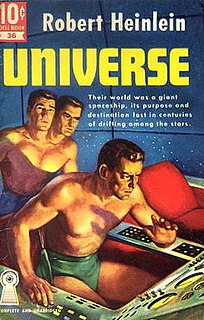
Future History is a series of stories created by Robert A. Heinlein. It describes a projected future of the human race from the middle of the 20th century through the early 23rd century. The term Future History was coined by John W. Campbell Jr. in the February 1941 issue of Astounding Science Fiction. Campbell published an early draft of Heinlein's chart of the series in the May 1941 issue.
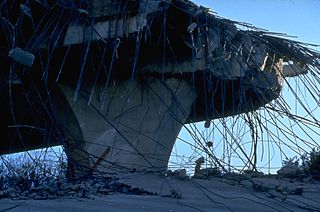
The 1994 Northridge earthquake was a moment magnitude 6.7, blind thrust earthquake that occurred on January 17, 1994, at 4:30:55 a.m. PST in the San Fernando Valley region of the City of Los Angeles. The quake had a duration of approximately 10–20 seconds, and its peak ground acceleration of 1.82 g was the highest ever instrumentally recorded in an urban area in North America. Shaking was felt as far away as San Diego, Turlock, Las Vegas, Richfield, Phoenix and Ensenada. The peak ground velocity at the Rinaldi Receiving Station was 183 cm/s, the fastest ever recorded.

The Imperial Valley of Southern California lies in Imperial and Riverside counties, with an urban area centered on the city of El Centro. The Valley is bordered by the Colorado River to the east and, in part, the Salton Sea to the west. Farther west lies the San Diego and Imperial County border. To the north is the Coachella Valley region of Riverside County, which together with Imperial Valley form the Salton Trough, or the Cahuilla Basin, also the county line of Imperial and Riverside counties, and to the south the international boundary with Mexico.
Jubal Harshaw is a fictional character featured in several novels by Robert A. Heinlein, most prominently 1961's Stranger in a Strange Land. He is described as: "Jubal E. Harshaw, LL.B., M.D., Sc.D., bon vivant, gourmet, sybarite, popular author extraordinary, neo-pessimist philosopher, devout agnostic, professional clown, amateur subversive, and parasite by choice."
"Space Jockey" is a science fiction short story by American writer Robert A. Heinlein. Part of his Future History series, it originally appeared in The Saturday Evening Post, April 26, 1947, and was collected in The Green Hills of Earth.

Richter 10 is a 1996 science fiction novel by Arthur C. Clarke and Mike McQuay. The protagonist is Lewis Crane, who develops a hatred of earthquakes due to a major earthquake hitting his house when he is seven years old, killing his parents. The book's title is a reference to the Richter scale, on which 10 was considered to be the most power an earthquake was likely to ever have.
The science fiction writer Robert A. Heinlein (1907–1988) was productive during a writing career that spanned the last 49 years of his life; the Robert A. Heinlein bibliography includes 32 novels, 59 short stories and 16 collections published during his life. Four films, two TV series, several episodes of a radio series, at least one song and a board game derive more or less directly from his work. He wrote a screenplay for one of the films. Heinlein edited an anthology of other writers' science fiction short stories.
The Heinlein juveniles are the science fiction novels written by Robert A. Heinlein for Scribner's young-adult line. Each features "a young male protagonist entering the adult world of conflict, decisions, and responsibilities." Together they tell a loosely-connected story of space exploration. Scribner's published the first twelve between 1947 and 1958, but rejected the thirteenth, Starship Troopers. That one was instead published by Putnam. A fourteenth novel, Podkayne of Mars, is sometimes listed as a "Heinlein juvenile", although Heinlein himself did not consider it to be one.

Off the Main Sequence: The Other Science Fiction Stories of Robert A. Heinlein (ISBN 1-58288-184-7) is a collection of 27 short stories by American writer Robert A. Heinlein, including three that were never previously collected in book form.
W. C. Tuttle was an American writer who sold more than 1000 magazine stories and dozens of novels, almost all of which were westerns.
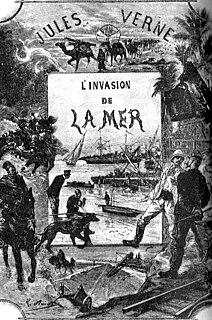
Invasion of the Sea is an adventure novel written by Jules Verne. It was published in 1905, the last to be published in the author's lifetime, and describes the exploits of Berber nomads and European travelers in Saharan Africa. The European characters arrive to study the feasibility of flooding a low-lying region of the Sahara desert to create an inland sea and open up the interior of Northern Africa to trade. In the end, however, the protagonists' pride in humanity's potential to control and reshape the world is humbled by a cataclysmic earthquake which results in the natural formation of just such a sea.
References
- 1 2 Oscar, Sundara (2011-10-01). Water Is for Washing. International Book Market Service Limited. ISBN 9786137955369.
- 1 2 3 4 Gifford, James (May 8, 2021). Robert A. Heinlein: A Reader's Companion. Citrus Heights, California: Nitrosyncretic Press. p. 173. ISBN 978-0967987408.
- ↑ "Water Is for Washing - Robert A. Heinlein". www.troynovant.com. Retrieved 2016-04-13.
- ↑ Wesselmann, Bethany. "Robert A. Heinlein". Historic Missourians. State Historical Society of Minnesota. Retrieved 26 February 2022.
- ↑ Franson, Robert Wilfred. "Flash flood in a desert valley". Troynovant, or Renewing Troy. Franson Publications. Retrieved 26 February 2022.